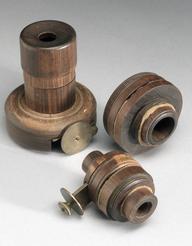

Reflecting circle made by Julius Wanschaff, Berlin, Germany, about 1875. Circular dark-brown and yellow-lacquered brass frame, with two wooden handles. Signed on the limb: Julius Wanschaff. Berlin 51. Lacquered brass limb with inlaid silver scale indicating from -5° to 130° and from 180° to 290°; the entire scale is divided every 10'. Two silver verniers to 10", zeros at the right. The tangent screw, working against a spring-loaded stop, and the clamping screw, are at the bottom of the index arm. Six half-glass shades (four red, two green), the shades can be moved away from the frame by a rising-piece; no horizon shades. Index glass and horizon prism without adjustment. Magnifier on a 130 mm swivelling arm, serving both verniers, a frosted glass shade. Threaded telescope bracket, perpendicular adjustment by rising-piece and a milled knob. Telescope (168 mm) inverted image, four cross-wires; extra draw tube (130 mm) inverted image, four cross-wires; extra draw tube (57 mm) erect image and a rotating shaded eye-piece with choice of clear, two red, and one green. A prismatic eyepiece, an adjusting pin. A square fitted mahogany box. The circle is mounted on a dark-brown and yellow lacquered brass column on a tripod stand with three milled levelling screws. The counterbalanced swinging mount can be locked into the desired position by milled screws.
Used by Sir David Gill (1843-1912) during his 1877 expedition to Ascension Island to observe Mars and improve the determination of solar parallax and hence the Astronomical Unit.
Details
- Category:
- Astronomy
- Object Number:
- 1876-998
- Measurements:
-
overall (estimate): 480 x 400 x 250 mm
- type:
- reflecting circle and instrument case
- credit:
- Wanschaff, J.




